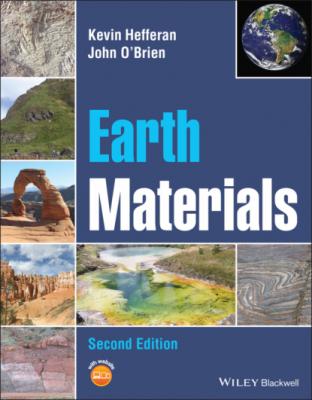Earth Materials. John O'Brien
Читать онлайн.| Название | Earth Materials |
|---|---|
| Автор произведения | John O'Brien |
| Жанр | География |
| Серия | |
| Издательство | География |
| Год выпуска | 0 |
| isbn | 9781119512219 |
Beta decay involves the ejection of a beta (β) particle plus heat from the nucleus. A beta particle is a high‐speed electron (e−). The ejection of a beta particle from the nucleus of a radioactive element converts a neutron into a proton (n0 − e− = p+) increasing the atomic number by one while leaving the atomic mass number essentially unchanged. The spontaneous decay of radioactive rubidium‐87 (Z = 37) into stable strontium‐87 (Z = 38) is one of many examples of beta decay.
Electron capture involves the addition of a high‐speed electron to the nucleus with the release of heat in the form of gamma rays. It can be visualized as the reverse of beta decay. The addition of an electron to the nucleus converts one of the protons into a neutron (p+ + e− = n0). Electron capture decreases the atomic number by one while leaving the atomic mass number unchanged. The decay of radioactive potassium‐40 (Z = 19) into stable argon‐40 (Z = 18) is a useful example of electron capture. It occurs at a known rate, which allows the age of many potassium‐bearing minerals and rocks to be determined. Only about 9% of radioactive potassium decays into argon‐40; the remainder decays into calcium‐40 (40Ca) by beta emission.
The heat released by radioactive decay is called radiogenic heat. Radiogenic heat is a major source of the heat generated within Earth. It is an important driver of global tectonics and many of the rock‐producing processes discussed in this text, including magma generation and metamorphism.
The time required for one half of the radioactive isotope to be converted into a new isotope is called its half‐life and may range from seconds to billions of years. Radioactive decay processes continue until a stable nuclear configuration is achieved and a stable isotope is formed. The radioactive decay of a parent isotope into a stable daughter isotope may involve a sequence of decay events. Table 3.2 illustrates the 14‐step process required to convert radioactive uranium‐238 (238U) into the stable daughter isotope lead‐206 (206Pb). All of the intervening isotopes are unstable, so that the radioactive decay process continues. The first step, the conversion of238U into thorium‐234 by alpha decay, is slow, with a half‐life of 4.47 billion years (4.47 Ga). Because many of the remaining steps are relatively rapid, the half‐life of the full decay, sequence is just over 4.47 Ga. As the rate at which238U atoms are ultimately converted into206Pb atoms is known, the ratio238U/206Pb can be used to determine the crystallization ages for minerals, especially for those formed early in Earth's history, as explained below.
Those isotopes that decay rapidly, beginning with protactinium‐234 and radon‐222, produce large amounts of decay products in short amounts of time. Radioactive decay products, especially alpha particles, can produce notable damage to crystal structures and significant tissue damage in human populations (Box 3.2). Radioactive isotopes also have significant applications in medicine, especially in cancer treatments. Radioactive decay provides a significant energy source through nuclear fission in reactors. Radioactive materials remain important global energy resources, even though the radioactive isotopes in spent fuel present long‐term hazards, expecially with respect to their disposal. As noted above, radioactive decay is also the primary heat engine within Earth and is partly responsible for driving plate tectonics and core–mantle convection. Without radioactive heat, Earth would be a very different kind of home.
Figure 3.12 Three types of radioactive decay: alpha decay, beta decay, and electron capture (gamma decay) and the changes in nuclear configuration that occur as the parent isotope decays into a daughter isotope.
Table 3.2 The 14‐step radioactive decay sequence that occurs in the conversion of the radioactive isotope238U into the stable isotope206Pb.
| Parent isotope | Daughter isotope | Decay process | Half‐life |
|---|---|---|---|
| Uranium‐238 | Thorium‐234 | Alpha | 4.5 × 109 years |
| Thorium‐234 | Protactinium‐234 | Beta | 24.5 days |
| Protactinium‐234 | Uranium‐234 | Beta | 1.1 minutes |
| Uranium‐234 | Thorium‐230 | Alpha | 2.3 × 105 years |
| Thorium‐230 | Radium‐226 | Alpha | 8.3 × 104 years |
| Radium‐226 | Radon‐222 | Alpha | 1.6 × 103 years |
| Radon‐222 | Polonium‐218 | Alpha | 3.8 days |
| Polonium‐218 | Lead‐214 | Alpha | 3.1 minutes |
| Lead‐214 | Bismuth‐214 | Beta | 26.8 minutes |
| Bismuth‐214 | Polonium‐214 | Beta | 19.7 minutes |
| Polonium‐214 | Lead‐210 | Alpha | 1.5 × 10−4 seconds |
| Lead‐210 | Bismuth‐210 | Beta | 22.0 years |
| Bismuth‐210 | Polonium‐210 | Beta | 5.0 days |
| Polonium‐210 | Lead‐206 | Alpha | 140 days |
Box 3.2 Radon and lung cancer
Inhalation of radon gas is the second largest cause of lung cancer worldwide, second only to cigarette smoking. In the 1960s, underground uranium miners began to show unusually high incidences of lung cancer. The cause was shown
